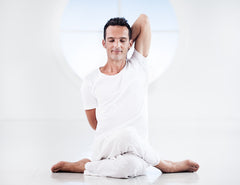- Home
- Teacher Training
- Audio Classes
- About
- Learn More
- Sign in
- Home
-
Teacher Training
-
Audio Classes
-
About
-
Learn More
March 18, 2019
The Hidden Potential of Gomukhasana
Gomukhasana is a wonderful multi layered posture, there is so much more to this posture than first meets the eye. Gomukhasana is regarded as a royal posture. The cow is greatly respected in India which means that this posture should be performed with respect and awareness. It provides a time for stillness and appreciation.
Gomukhasana translates from Sanskrit as follows Go = Cow, Mukha = Face. The Cow Face posture and it is also referred to as head of the cow.
Next time you perform this posture, why not spend a little longer than usual in it? Holding the posture allows you to observe and experience the many sensations and benefits that this posture brings.
To bring you into the present moment when performing this yoga posture notice all physical sensations that you experience, observe your breath and become fully aware of the flow of prana and all the energetic sensations that this posture brings.
 How to perform Gomukhasana
How to perform Gomukhasana
Begin sitting in Dandasana (the staff pose), both legs are extended and the spine is straight. Bend your right knee, crossing the right leg over the top of the left and positioning the right foot beside the left hip. Now bend the left knee directing the left foot towards the outside of the right hip. The feet should be on their outside edges take your time to line the knees up, so that the right knee is on top of the left, now move the feet if possible so that they are level.
Try to keep both sitting bones on the floor and the torso square to the front. Keep a straight spine as you lift your left arm straight up beside your left ear. Bend the elbow, so that the left hand is behind your back, now reach the right arm behind the middle of your back with the fingers pointing up if possible clasp your hands. Sit tall drawing up your lower stomach muscles. Soften the shoulders whilst continuing to extend the left elbow up. Imagine a diagonal line from elbow to elbow helping to increase the space between your elbows. Direct your gaze to the tip of your nose or close your eyes.
Stay in this posture as you scan through your body and notice any physical sensations, release tension as you exhale, soften the face and breathe slowly through the nose. Feel that the raised elbow acts as an aerial to attract energy. Picture prana entering the body through this point and see yourself creating a triangular shape with your body. Notice energy travelling through your body as you hold this posture without bringing any tension into the body; spend time softening and releasing whilst encouraging prana to enter the body energising your whole being.
After spending sometime in this posture release the arms, uncross the legs, and repeat with the arms and legs reversed holding for the same length of time. Remember that whichever leg is on the top the opposite arm is raised.
Note in an Ashtanga practise this posture is often performed using the same arm and the same leg.
The Benefits of Gomukhasana
Special Considerations
Gomukhasana is notoriously difficult for some practitioners; if you experience discomfort it is possible to elevate the hips by sitting on a yoga bolster or a few folded towels, or just cross the ankles (sukhasana) and remember that whichever leg is crossed in front raise the opposite arm.
If you struggle to clasp your hands behind your back use a yoga strap, hold the strap in the top hand allow the strap to hang down the back and grasp it with the bottom hand as you take the lower arm behind your back.
The Cow in Hindu Folklore and Mythology
It is believed that all cows are descended from Kamadhenu also known as Surabhi the symbolic cow of supreme abundance, Kamadhenu is able to grant all wishes and desires. Pictures and sculptures of Kamadhenu can be seen throughout India, showing the body of a cow with the face of a beautiful woman providing her master with all the milk that he desires. The horns symbolise the gods, the face symbolises the sun and the moon, the shoulders symbolise Agni (God of Fire) and the legs symbolise The Himalayas.
In some areas of India cow dung has been used for purification and is rubbed into the ground of areas considered unclean. It is also rubbed into doorways in rural areas for purification as the first job of the day. Even today we have to consider the role that cattle has played helping civilisations advance and evolve.
This blog article was written by Sue Fuller creator of the Yoga 2 Hear range of audio yoga classes and yoga teacher training courses.
Sign up to get the latest on special offers, new releases and much, more. We we promise not to bombard you with endless emails and as a thank you, you will receive you a FREE Relaxation Download that is yours to keep.
© 2025 Yoga 2 Hear.
All rights reserved.
